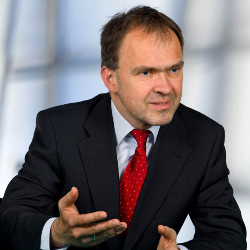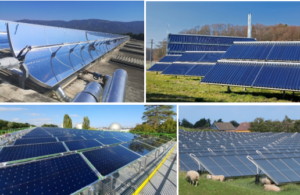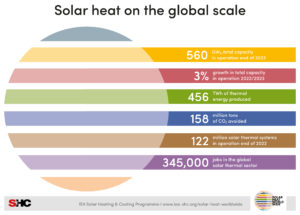Austria: “Heat networks must enable decentralised feed-in options”
October 2, 2014
 “Renewables have turned the world of electricity upside down,” the former Managing Director of Austria Solar, Roger Hackstock, writes in his book Energiewende – Die Revolution hat schon begonnen (roughly translated as Energy Transformation – The Revolution Has Already Begun) published at the beginning of this year. Hackstock’s words refer to the grid’s high share of renewable electricity supply, which has caused electricity prices to tumble on the European Energy Exchange (EEX). Solarthermalworld.org spoke with the book author about what impact the price turbulence at the exchange has had on the heating market.
“Renewables have turned the world of electricity upside down,” the former Managing Director of Austria Solar, Roger Hackstock, writes in his book Energiewende – Die Revolution hat schon begonnen (roughly translated as Energy Transformation – The Revolution Has Already Begun) published at the beginning of this year. Hackstock’s words refer to the grid’s high share of renewable electricity supply, which has caused electricity prices to tumble on the European Energy Exchange (EEX). Solarthermalworld.org spoke with the book author about what impact the price turbulence at the exchange has had on the heating market.
Solarthermalworld.org: How has the heating market been affected by the dramatic drop in electricity trading prices on the EEX?
Hackstock: Among all power plants which trade their electricity on the EEX, it is the ones with the lowest fossil fuel costs that determine the price. For decades, nuclear and coal plants had had the edge here. In 2010, the EEX created new trading opportunities by including green electricity, and this energy source is virtually for free because you don’t have to deal with the costs of fossil fuel consumption. If the grid contains a lot of electricity from wind and solar energy, the more expensive power plants will be pushed out of the exchange. Often, these are gas-fired combined heat and power plants, or CHPs, which generate both electricity and heat. Here, you can see the connection to the heating market if such plants supply heat to bigger cities. When a gas-fired CHP plant cannot sell its electricity supply, it won’t produce heat either, which poses a challenge to the heat network.
Solarthermalworld.org: Does this mean that municipal energy companies, meantime, have incurred losses when operating gas-fired CHP plants?
Hackstock: When they cannot sell their electricity on the exchange but still have to deliver the heat energy, some municipal suppliers are indeed forced to operate their gas-fired CHP plants even though they lose money with it. Actually, they would have to recoup their losses by passing the costs on to customers. That, however, has been an issue of political relevance in many communities and will hardly win over any voters. Heating prices have always been low because the heat from the nationwide network is actually waste heat from the electricity produced for trading purposes, and city councils are opposed to the idea of asking their constituents to pay more for their heat supply.
We are currently experiencing these difficulties on a massive scale in the Austrian cities of Vienna and Graz. In Graz, the capital of Styria, the energy utility Verbund announced in May 2014 that it intends to shut down the gas and coal plants in Mellach south of the city until 2020 – which means that in six years, almost 80 % of the today’s heat supply will be missing.
Solarthermalworld.org: Which alternative heat sources are being discussed there?
Hackstock: All available options are being evaluated, from geothermal and biomass to solar heat. This, however, has led to the realisation that the 140 °C and 15-bar heat networks, which supply an entire city from a few central locations, are not particularly apt for feeding in renewable heat. What is needed is a culture change. How do we get from high-temperature and high-pressure heat networks with a small number of feed-in sites to smaller individual installations with many feed-in locations and lower return temperatures, installations which will cover peaks in heat demand by decentralised storage systems?
It’s not only about technology here: We need new tariff models, too. In Denmark, district heating operators offer customers a remarkably cheaper heat price if they achieve such a good hydraulic adjustment of their heating systems that return temperatures stay below a certain level. This will greatly improve the utilisation of renewable heat sources like solar thermal and increase their efficiency as well.
Solarthermalworld.org: How do energy providers respond to these new challenges?
Hackstock: The heating sector is clueless as to how it should continue with the gas-fired CHP plants in the towns and cities. Most energy suppliers stick to their usual one-central-source thoughts: When I recommend to them that they must unable decentralised feed-in options for heat supply, they only see a chaotic and anarchic future coming. They cannot imagine that even a decentralised network with many feed-in sites and storage systems can ensure stable temperatures throughout the entire year. Basically, these are the same responses we got from the electricity industry 15 years ago, when grid access was offered to third parties during market liberalisation. Back then, the electricity suppliers foresaw a blackout when many decentralised feed-in sites would negatively influence network safety and lead to emergency shutdowns. But the blackout didn’t occur because the utilities developed an intelligent regulatory framework for grid management and the governments promoted the expansion of low-voltage electricity grids. Heat networks will require the same kind of innovations to enable the use of decentralised energy sources. Compared to the electricity sector, the heating market is lagging more than 10 years behind in such developments.
The interview was conducted by Bärbel Epp.
More information:
Energiewende – Die Revolution hat schon begonnen: http://www.kremayr-scheriau.at/bucher-e-books/energiewende-642 (in German)


